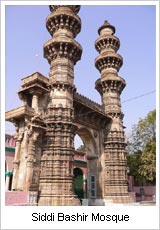Introduction:
Ahmedabad the largest city in Gujarat blends an ancient heritage
with a vibrant present. It nurtures in its pages of history,
a breath of harmony and a show-case of exquisite harmony.
The city is named after a Sultan who founded it in 1411 and
graced it with splendid monuments. Ahmedabad is also known
for its association with the Apostle of peace Mahatma Gandhi
whose ashram is on the banks of River Sabarmati which is now
a national pilgrimage site. Ahmedabad is the second largest
prosperous city in Western India. It is a place where tradition
and modernity co-exist in perfect harmony. The climate of
the state is moist in the southern districts and dry towards
the northern sides. Ahmedabad has been a city where a lot
of action, reaction and interaction between various ethnic
and linguistic forces has taken place which has resulted in
the synthesis of many races and cultures. It is a land of
gentle, dignified people, astute businessmen, gay, colourful
peasants, and thriving industry.
Sightseeing:
Rani Rupmati Masjid:
Rani Roopmati Masjid, with its exquisite details and the grand
Shah Alam complex are a living tribute to the reign of Muhmad
Shah Begra of the 15th century. The Queen's Mosque in Mirzapur,
built between 1430 and 1440, is more representative of the
pattern of mosque building in 15th century Ahmedabad. Three
domes stand on 12 pillars each, with the central part so raised
as to let in natural light without direct sunlight.
Siddi Bashir Mosque:
Known as Shaking Minaret or Jhulta Minar. When one minarets
is shaken the other one begins to vibrate. The mosque was
obviously built by master craftsmen and the crucial mechanism
that causes the vibration is still a mystery.
Gandhi Ashram:
Set up on the quiet peaceful stretch of Sabarmati River, 7
kms north of the city, this was the Hriday Kunj of Mahatma
Gandhi and for many years it was the nerve centre of India's
freedom movement. It was from here, in 1930, that Mahatma
began his famous Dandi March to the sea to protest against
the salt tax imposed by the British. The Gandhi Ashram has
a memorial centre, library and a Sound-and-Light (Son et Lumiere)
spectacle to offer to its visitors.
Calico Textile Museum:
Ahmedabad has one of the finest textile museums in the world.
Housed in one of Gujarat's famous carved-wooden havelis, the
museum displays a magnificent collection of rare textiles
that date back to the 17th Century. There is also an excellent
reference library on textiles.
Hatheesing Jain temples:
Built outside Delhi Gate in 1850 by a rich Jain Merchant,
this is the best known of Ahmedabad's many ornate Jain Temples.
Built of pure white marble and profusely decorated with rich
carvings, the Hatheesing Temple is dedicated to Dharamnath.
Jama Masjid:
One of the finest mosques in India with 260 pillars supporting
15 domes at different elevations, it was build by Ahmad Shah
in 1423 and is located in the center of the old city.
Kankaria Lake:
It is a circular lake constructed in 1451 by Sultan Qutubub-Din.
In the center of the lake is an island garden with a summer
palace known as Nagina Wadi. The lake is a popular recreation
center surrounded by parks, 'Bal Vatika', an aquarium, a boat
club, a natural history museum and a zoo.
How to reach :-
Ahmedabad is situated in western India at 53 meters above
sea level. It is well connected by air to rest of the country.
Ahmedabad is one of the six operating divisions of the Western
Railway, railway lines connect the city to all towns in Gujarat,
and to major cities in the rest of India. Except the Monsoon
season, the climate of Ahemdabad is generally dry. Best time
to visit Ahmedabad is between September and March.
Best period to visit Ahmedabad :-
The climate of Ahmedabad is hot and moist. Winters are cool
and pleasant (November-February) but summers (April-June)
are extremely dry, hot in Ahmedabad and the temperature can
be as high as 46°C at times. The city of Ahmedabad experiences
good rainfall during the monsoon season during the months
from July to September.
| |
 |

